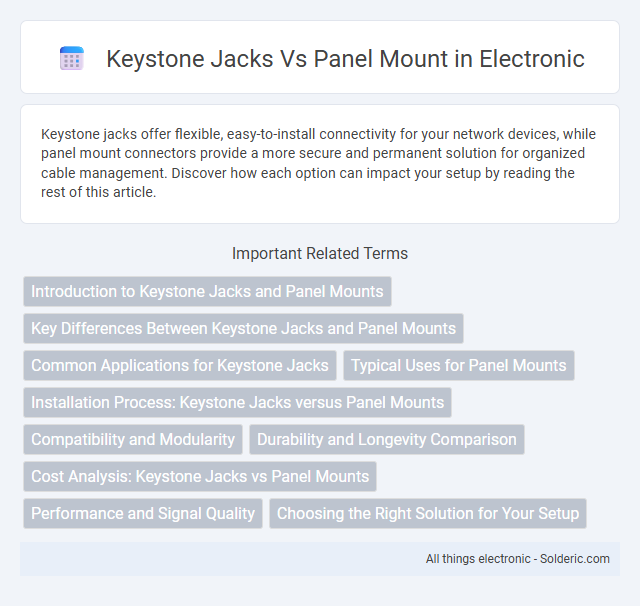Keystone jacks offer flexible, easy-to-install connectivity for your network devices, while panel mount connectors provide a more secure and permanent solution for organized cable management. Discover how each option can impact your setup by reading the rest of this article.
Comparison Table
| Feature | Keystone Jacks | Panel Mount |
|---|---|---|
| Definition | Modular connectors used in patch panels and wall plates for network cabling. | Fixed connectors mounted directly on panels for secure cable connections. |
| Installation | Snap into keystone wall plates or patch panels, easy to replace. | Bolted or screwed onto panels, requires tools for installation and removal. |
| Flexibility | Highly modular and easy to customize or upgrade. | Less modular, designed for permanent setups. |
| Use Cases | Ideal for structured cabling and network outlets. | Suitable for equipment panels and fixed connection points. |
| Compatibility | Compatible with standard keystone faceplates and patch panels. | Depends on specific panel dimensions and connector types. |
| Durability | Good for frequent reconfiguration and replacement. | Robust for stable, long-term installations. |
| Cable Types | Supports Ethernet cables (Cat5e, Cat6, Cat6a, Cat7). | Supports a variety of cables depending on connector type (Ethernet, coaxial, audio). |
Introduction to Keystone Jacks and Panel Mounts
Keystone jacks and panel mounts are essential components in structured cabling systems, enabling secure and organized connections for Ethernet, audio, and other data cables. Keystone jacks are modular connectors that snap into keystone wall plates, providing flexibility for various cable types and easy installation or replacement. Panel mounts, on the other hand, are fixed connectors designed to attach directly to equipment racks or panels, offering robust cable management and a sturdy interface for high-density networking environments.
Key Differences Between Keystone Jacks and Panel Mounts
Keystone jacks are modular connectors designed for easy snap-in installation into wall plates or patch panels, offering flexibility for network setups and quick port changes. Panel mounts are fixed connectors attached directly to equipment or enclosures, providing robust and permanent cable connections ideal for industrial or high durability needs. Your choice depends on whether you prioritize modular versatility with keystone jacks or rugged, stable connections with panel mounts.
Common Applications for Keystone Jacks
Keystone jacks are widely used in structured cabling systems for networking and telecommunications due to their modular design and easy customization. Common applications include patch panels, wall plates, and surface mount boxes in residential, commercial, and industrial environments. Their compatibility with various connectors, such as RJ45 for Ethernet and RJ11 for phone lines, makes them ideal for flexible, scalable network installations.
Typical Uses for Panel Mounts
Panel mounts are commonly used in structured wiring systems for secure and organized cable management in network racks and patch panels. These mounts provide a stable interface for connecting Ethernet, audio, or video cables in telecommunications rooms and data centers. You can rely on panel mounts for enhanced durability and consistent performance in professional AV installations and industrial control systems.
Installation Process: Keystone Jacks versus Panel Mounts
Keystone jacks offer a straightforward installation process by snapping into compatible faceplates or patch panels, enabling quick and tool-free connections suitable for modular setups. Panel mount connectors require precise alignment and secure fastening using screws or brackets, providing a robust, permanent installation ideal for industrial or rack-mounted environments. The choice between keystone jacks and panel mount connectors depends on the desired balance between ease of installation and long-term stability.
Compatibility and Modularity
Keystone jacks offer high modularity by allowing easy insertion and removal within compatible patch panels, wall plates, and surface mounts, making them versatile for various network setups. Panel mount connectors, designed for fixed installation on equipment or panels, provide robust compatibility with specific devices but lack the flexible interchangeability of keystone jacks. Your choice depends on whether you need adaptable modularity or a permanent, device-specific connection solution.
Durability and Longevity Comparison
Keystone jacks are designed for easy snap-in installation with moderate durability, suitable for environments with minimal physical stress, while panel mount connectors offer enhanced robustness and secure fastening, making them more resistant to wear and tear in demanding settings. Panel mount options often feature metal housings and reinforced components that extend their longevity under frequent use or harsh conditions. For optimal performance and longer lifespan in your network setup, choosing panel mount connectors ensures greater durability compared to standard keystone jacks.
Cost Analysis: Keystone Jacks vs Panel Mounts
Keystone jacks generally offer a lower upfront cost compared to panel mounts, making them a budget-friendly option for small-scale or residential installations. Panel mounts, while initially more expensive due to their robust design and higher durability, provide long-term savings by reducing maintenance and replacement needs in large or commercial networking setups. Evaluating your project's scale and expected usage will help determine if the cost efficiency of keystone jacks or the durability of panel mounts aligns better with your network infrastructure investment.
Performance and Signal Quality
Keystone jacks provide reliable performance with low crosstalk and consistent signal quality for structured cabling systems, making them ideal for standard network installations. Panel mount connectors offer enhanced durability and shielding, which improves signal integrity in high-interference environments and critical applications requiring minimal signal loss. Both options support high-speed data transmission, but panel mounts typically excel in maintaining optimal performance under harsh conditions.
Choosing the Right Solution for Your Setup
Keystone jacks provide modularity and easy customization for patch panels or wall plates, ideal for dynamic environments requiring frequent reconfiguration. Panel mount connectors offer a robust, secure connection directly integrated into equipment or enclosures, perfect for fixed installations demanding durability and minimal maintenance. Assessing your setup's flexibility needs, space constraints, and environmental conditions will guide the optimal choice between keystone jacks and panel mount solutions.
Keystone jacks vs Panel mount Infographic

 solderic.com
solderic.com